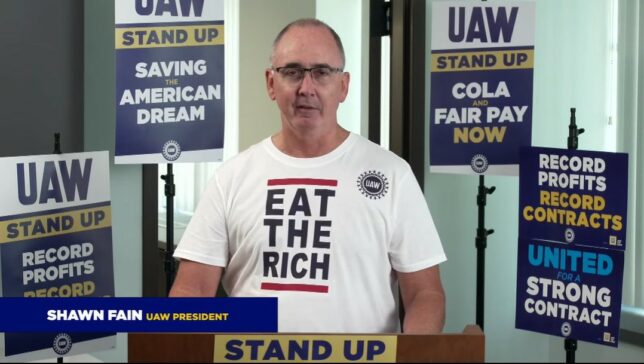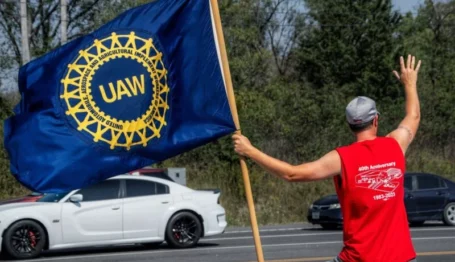Labor Watch
The Price of Bent Unions Is Red Unions
 Shawn Fain, president of the United Auto Workers, wearing his signature t-shirt. Credit: United Auto Workers/YouTube.
Shawn Fain, president of the United Auto Workers, wearing his signature t-shirt. Credit: United Auto Workers/YouTube.

Corruption within organized labor is pervasive enough that movies have been made about it, federal legislation has been passed to combat it, and senior union officials have done hard time for it, But what happens to a union after the thieves, Mafiosi, or corrupt political fixers have been driven out by the long arm of the law?
Frequently, they are taken over by organized ideological radicals—Communists in the old days, but more recently cadres influenced by Students for a Democratic Society and New Left elements or contemporary Everything Leftism. This repeating pattern tells a truth about the people who really run labor unions as opposed to the reality imagined by supposed conservatives funded by pro-abortion and anti-capitalist institutional foundations and liberal mega-donors who heavily funded the 2016-era Never Trump movement. The people running labor unions are often taking members’ money for either crooked purposes or radical ideological purposes—or even both at the same time.
How Crooks Made Red Hollywood
Examples of corrupt union leaders being challenged or replaced by radical cadres after a cleaning out go back decades. In the late 1930s, the Hollywood stagehands’ union—part of the International Association of Theatrical Stage Employees (IATSE)—was led by corrupt leadership. George Browne and William Bioff would be charged with and convicted of extortion and labor racketeering, creating an opening for the rival Conference of Studio Unions (CSU), led by Herbert Sorrell, a crusading strike leader associated with a local of the Painters’ Union.
But Sorrell was also (most probably) a Communist. For approximately a decade, Sorrell’s presumptively Red-aligned CSU battled the corruption-battered IATSE. The conflict culminated in a 1946 strike over jurisdiction (the power of a union, rather than some other union, to organize and represent a certain class of workers) that Sorrell and his CSU lost thanks to intervention from national labor leadership, including the head of the Screen Actors’ Guild, one Ronald W. Reagan.
Why the Teamsters Are Everything Leftists Now
The most famous case of labor corruption in American history is the long domination of the International Brotherhood of Teamsters by organized crime in the mid-to-late 20th century. That domination coincided with the union’s unusually Republican-friendly (or at least not-hostile-to-Republicans) political orientation. By the early 1990s, however, federal government litigation and a consent decree had ousted the Mob-compromised regime that had taken over the union since the rise of Jimmy Hoffa (at the expense of another more common crook, Dave Beck).
Who became the first Teamsters president selected by the union membership at large was a hot battle, but the advantage lay with Ron Carey, who had the endorsement of the Teamsters for a Democratic Union (TDU). TDU was a long-standing “reform” caucus opposed to the Mob-controlled leadership of the union, but the caucus’s interests went beyond mere good governance and fiduciary respect for members’ dues. Its founders included members of the International Socialists, a group founded by an ex-Trotskyite.
So it shouldn’t be that surprising that Carey ended up a committed partisan Democrat, if not a hard leftist like some of his backers. Indeed, Carey’s Democratic partisanship unmade his union presidency in a scandal in which his union threw hundreds of thousands of dollars into left-wing organizing and voter mobilization groups (most prominently Citizen Action). The groups helped then-President Bill Clinton’s re-election campaign and then paid kickbacks to Carey’s own re-election campaign to the union presidency.
That was (and is) a no-no under the Labor Management Reporting and Disclosure Act and resulted in Carey’s re-election being thrown out. He was replaced by James P. Hoffa, son of the infamous Jimmy. Unlike his notorious father, James Hoffa kept his nose clean and his union pointed firmly to the left, joining the left-wing Service Employees International Union in the Change to Win labor union alliance, which failed to supersede the AFL-CIO.
Raising Fain
The rising star of contemporary organized labor is Shawn Fain, the left-wing leader of the United Auto Workers. He wears “eat the rich” shirts to public events, campaigns for a ceasefire between Israel and Hamas, and calls for the “just transition” to electric vehicles (whatever that may do to his members). Riding high after his perceived victories in the “historic” strike against the Detroit Three automakers, Fain rose to power only because of one of the worst union corruption scandals in the UAW’s previous regime.
Long story short, the regime that ran the UAW from the 2008 financial crisis until about 2020 was neck-deep in taking kickbacks from employers, straight-up embezzlement, and other forms of labor corruption. Two former UAW presidents went to prison for their involvement in various thefts. All told, at least 17 UAW leaders were convicted. One leader, General Holiefield, avoided prosecution by dying of natural causes before the investigation had matured.
The legal settlements that the UAW made with the federal government to avoid the full government scrutiny of the post-Mob Teamsters included a familiar change to the manner of election of the union’s national president. Instead of an electoral college of union-elected officers, the union’s general membership would popularly elect the president. (The Teamsters adopted such a change in their consent decree that led to Carey’s rise.)
And like the Trotskyite-and-SDSer-backed Carey replacing the old Teamster regime, the ideologically radical Fain replaced the machine Democrats who had been caught with their hands in the cookie jar. (To get an idea of how closely the UAW and the Democratic machine had been, Norwood Jewell, a UAW vice president who went up the river for his involvement in a kickback scheme with Fiat Chrysler officials, had been a member of the Democratic National Committee.) The pattern repeated.
The Lesson
It’s important to point out that the lesson of this pattern isn’t that corrupt unions are somehow “better” than their ideologically fanatical alternative. Every political activist, no matter how wrong on policy, deserves to have money that he or she voluntarily contributes to advocacy groups be used for the purposes for which it was contributed, rather than lining the leaders’ pockets. (Inclination to this sin does not distinguish by party or ideology, it must be said.)
But for a worker considering unionization or a conservative movement considering whether to rethink its eight-decade consensus of skepticism of organized labor, it is a glaring warning signal. While unions may sell the promise of “more” for the workers, the people who run them often seek “more” for themselves or “more” for political ideologies on the fringe of the American Left. And union organizing campaigns are functionally “one man, one vote, one time” if the union wins. Workers should fully inform themselves before choosing.



